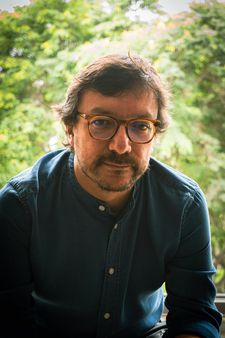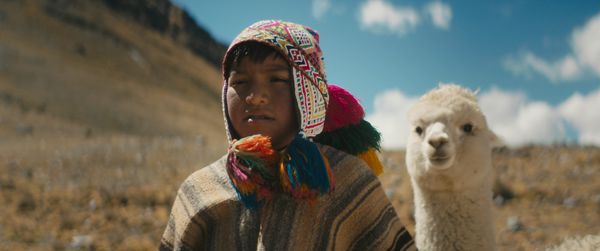Through Rocks And Clouds tells the story of the son of a family of alpaca herders. Feliciano (Alberth Merma is beyond excited at the prospect that Peru could qualify for the football World Cup. But there is trouble brewing closer to home thanks to the dirty tricks of a local mining company. Director Franco García Becerra mixing a fantastical element of a lake spirit Auki Tayta in with his naturalistic drama in this family-friendly film. We caught up with Becerra and Annemarie Gunkel, who co-wrote the script with Alicia Quispe, to talk about blending the real and the imagined while keeping a child's viewpoint.
What made you want to tell this story?
Franco García Becerra: The script was written by Annemarie Gunkel and Alicia Quispe, and it's interesting because this story started with an image Anna saw during a walk in Cusco City. She saw this little boy listening to a football game on the radio, while in the main city, all the people were watching the game through these big screens. And this is the starting point for the story. They invited me to direct the film. And it's interesting because I noticed since the beginning that this story was to be told in Quechua. There was no other option in order to make a mirror of the community of the culture. I’m from Cusco, Annamarie has lived a lot of time in Cusco and knows the community very well. So this helped me to provide a point of view for the movie as well. It was inspired by the place and we tried to keep the essence of it.
They always say you should never work with children or animals - and here it’s not just one animal, it’s a herd of alpacas and a dog.
 |
| Franco García Becerra: 'I decided to always work with metaphors and to always keep the point of view of the boy' |
So does Alberth herd the alpacas in real life?
FGB: Yes, it’s the family’s herd and Albert’s pet alpaca is Ronaldo. He raised him because he was an orphan, which is why he’s very tame. Both he and Rambo the dog are the family’s pets so it made it very natural.
I wanted to ask you about the lake spirit that’s in this film and how you came to include it. It’s also interesting that it retains an element of mystery, as it’s part of Feliciano’s imagination, so the way you shoot it is also interesting.
Annemarie Gunkel: So the script was written after a lot of research with my co-writer Alicia. She is from the region and is a Quechua speaker. I'm learning Quechua and I have a lot of friends and family bonds, for example my goddaughter is from that region. So we collected a lot of information about Auki Tayta. He has different names in different regions and people imagine him in different ways. So we chose to give him one attribute from one story we heard because we really liked that he has an alpaca coat. And so the interpretation then was made by Franco and his art director from all the investigation we made previously.
FGB: There are many forms of Auki Tayta, so we chose never to show him totally to respect the diversity of these imaginations, and to keep the feeling alive because it's more of a feeling than an image. I wanted to transmit that by just revealing parts of him, like his alpaca outfit, and viewing him from far away.
He has the sort of danger that children like to see in movies - he’s a bit scary without being enough to give them nightmares.
FGB: We didn't want it to be too scary, but to show it as something that is present and something that people have respect for. They have respect for these spirits.
You’re walking a careful line with this film because alpacas are killed in it as well. This is a family film but you need to show there are problems with the mining companies. How do you work together on that at a script level and then shooting so that it brings home the threat but it’s also a film children can still watch?
AG: We wrote it from the perspective of a child, so he might not be conscious of it even if there's really bad stuff happening around him or dangerous things. So that’s what makes it possible to bring it to a child audience.
 |
| Feliciano (Alberth Merma) and Ronaldo. Franco García Becerra: 'There was no need to fictionalise the interaction because the relationship was already there' |
FGB: One could be tempted to exaggerate or show too much. To show too much of the mining maybe or to show too much of the monster so I decided to always work with metaphors and to always keep the point of view of the boy. It’s a film of metaphors and sensations. You feel a kind of presence of the monster around but I didn’t want to show too much.
How much rehearsal did you have? And was some of it shot more in a documentary, naturalistic style?
FGB: All the actors had the script and read it but then they kind of took the message of the dialogue and expressed it in their own way. Even some of the extras came up during filming and intervened and said something. It came out well, so we kept the scenes. The dynamic was to keep the essence of the script but let their dialogue flow.
But you didn’t want it to be a documentary
FGB: I wanted to keep it as real as possible without it becoming a documentary. We’ve spoken about the fine line about the monster and going to the horror side of things. Well, there's also a very fine line you can fall over into documentary and I didn’t want to do that, which is why I always kept the boy’s point of view.
This is an area that doesn’t get seen so much in films, so are you looking to return to it with future work
FGB: I’m from Cusco, so I definitely want to keep working in that area and I want to go more into the fantastical world view.
AG: In my case I like to discover regions and connect with stories that are not shown so much or unknown. Right now I have a script, Caminantes (walkers), which is set on the coastline. It’s about women migrating. And I’m also working on a short film in the Andes.





















